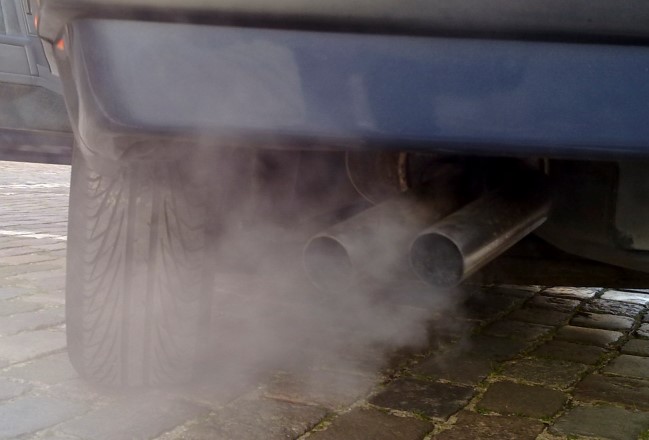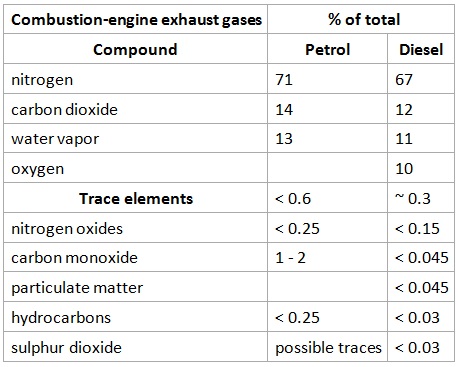Turn off your car engine every time you stop for more than 30 seconds.
If you don’t have a car or a license, ask the one driving you to do it.

“Environmental pollution is an incurable disease. It can only be prevented.”
-Barry Commoner
Hi, guys!
There’s been a lot of discussions about car exhaust in the past decade. Basically, all car producing companies have made many improvements in that area. Moreover, electric cars finally found a place in this world.
Many of us heard about often mention CO2 and carbon footprint, but in reality, most of us don’t even know, what comes out of the car exhaust. Therefore we should take a closer look at what is in car exhaust.
But first, we should tell you what exhaust gas is in the first place. We’re sure many of you know that already, but just in case, let’s write it down.
What is an exhaust gas?
Exhaust gas or flue gas is a homogeneous mixture of different molecules in a gaseous state, which is emitted as a result of the combustion of fuels (natural gas, gasoline, petrol, biodiesel blends, diesel fuel, fuel oil, or coal). That gaseous mixture is discharged into the atmosphere through an exhaust pipe, flue gas stack, or propelling nozzle.

What is in car exhaust?
Let’s break it down into types of molecules that come out of our cars:
- Non-toxic molecules (largest part):
- nitrogen (N2),
- water vapor (H2O),
- carbon dioxide (CO2).
- Undesirable noxious or toxic ones:
- carbon monoxide (CO) (from incomplete combustion),
- hydrocarbons (CxHy or simply “HC”) (from unburnt fuel),
- nitrogen oxides (NOx) (from excessive combustion temperatures, and particulate matter – mostly soot).
The exact composition of exhaust gas depends on the type of engine the machine uses. Let’s take a look at the exhaust composition of a petrol and diesel-driven cars.

Looking at the table above, we can see that by far the greatest portion of the exhaust gases represents nitrogen, but the second place goes to CO2. Since carbon dioxide is a greenhouse gas that contributes to global warming, it poses a threat to the environment.
To get a bit clearer picture, let’s take a look at some average quantities of potentially harmful exhaust gases that are released into the air. (Numbers given are for an average passenger car in the US.)

For CO2 those numbers are a bit lower in Europe since on average we drive more cars with lower fuel consumption.
Quite a lot has been done in that field – we can find some electric cars and even more hybrids on the road nowadays, and many new cars have an “auto-engine-off” function built-in.
For those of us that don’t drive an electric or hybrid car or have a new car with an “auto-engine-off” function, do your best to successfully perform this week’s challenge. Furthermore, try and make it a habit.
Here is a quote for those of you “green” oriented people and wealthy enough that can afford an electric car:
“Electric cars aren’t pollution-free; They have to get their energy from somewhere.”
-Alexandra Paul
If you’re interested to find out more about how and why electricity production causes pollution, you can take a look at our first challenge – “Saving energy is easy!”.

You see, even you guys can do something good for the environment by joining in on this challenge. 😉
How do I know when I will stop for more than 30 seconds?
We are quite sure you know that we don’t want you to start turning off your car engine at every stop sign, right? It’s not always possible to know if the stop will be really short or maybe you’ll stop for 30 seconds or more.
For those kinds of situations, it’s up to you to decide. But there are some situations when you simply know that the stop will be a bit longer. Here are some typical situation: waiting for a green light at the traffic light, held in a traffic jam that’s not moving, waiting for a train to pass, waiting for a person you’re picking up, waiting due to a construction work, …
Trust your guts, in most cases as a driver you simply know if the stop will be longer than 30 seconds.
Those of you who read and maybe even took part in the challenge #9 – “Why do people eat meat?” – you might be thinking that this week’s challenge is quite pointless since the meat industry is responsible for the major portion of the air pollution.
Well, you know our motto – we should all do the best we can to save the environment – so this is one of your chances to do your best. 😉
“Doing our best is more important than being the best.”
-Zig Ziglar
Take-home points:
-
What is in car exhaust? N2, water vapor, CO2, CO, hydrocarbons, and nitrogen oxides.
-
CO2 is a greenhouse gas that contributes to global warming.
-
Reduce CO2 by turning off your car engine when you stop for more than 30 sec.
-
When it comes to doing something good for the environment every “baby step” counts.
Have a great week.
Love,
Good Earthlings

Hi, this is a really cool site with a great concept of a challenge a work. I agree that to make the changes we need to ensure that the planet’s future is protected we all need to be making small steps. I am not a car owner and try to commute as much as possible by bike but sharing the roads with cars gives me a first hand experience of what is in car exhausts at it’s not pleasant!
Hi Manny!
Thank you for sharing your thoughts with us. Stay in touch.
Love, Good Earthlings
Wow…!
I have to honestly say that I had no idea that exhaust fumes had all of that bad stuff in it.
Your website definitely shows people exactly what is coming out of their exhaust.
I know this… When I’m stopping to run in a store, and always at a railroad crossing, I’m turning my car off. Thank you for educating me.
Alan
Your more than welcome, Alan. Thank you for stopping buy. We hope, you’ll join in on our Be a Good Earthling challenge.
Warm regards, Good Earthlings
Hello there,
Thanks for the interesting article. I always do what you described here. Not only that you pollute the environment less by turning your engine off, you also save some of your own money because your fuel doesn’t go into nothing. I personally would love to have the START-STOP feature in my next car which basically turns off your car whenever you stop and automatically turns it back on when you step on the paddle. Do you perhaps already have a car like that ?
Hi!
Thank you for sharing your thoughts with us. It’s nice to hear that you’re turning off your engine. Keep up the good job. 🙂 We don’t have start-stop feature, but it’s something our next car will sure have.
Warm regards